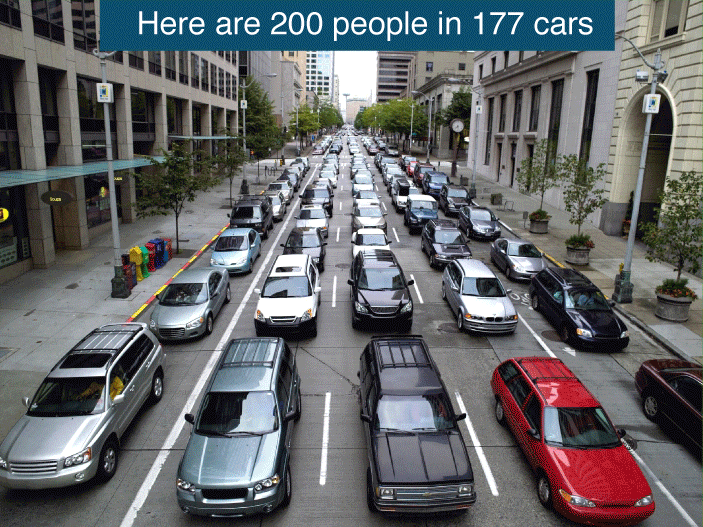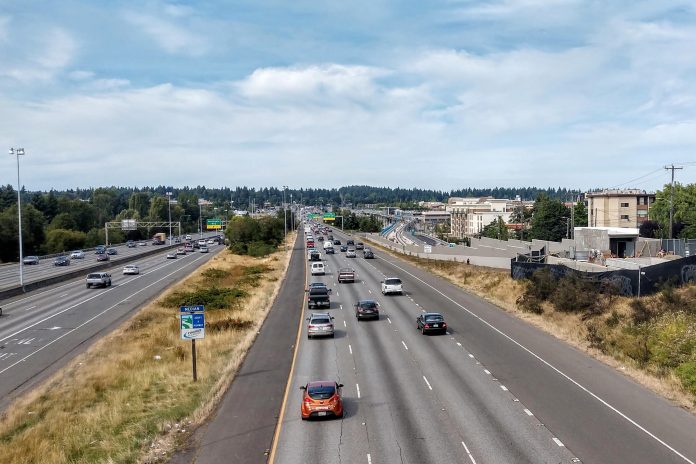The four-billion-dollar-and-counting SR-99 tunnel was supposed to relieve congestion. It’s been open nine months, but people getting around on Seattle streets and highways probably don’t feel too relieved. Traffic congestion continues to be a part of life in booming Seattle, and tunnel tolling, which started Saturday, may just move more traffic from the tunnel to city streets.
For the widen highways crowd, the opening of the Alaskan Way boulevard (in the footprint of the mercifully dismantled highway viaduct) is the light at the end of the tunnel. But that surface megaboulevard–eight lanes at its widest–isn’t likely to solve congestion either. Traffic tends to fill the vessel it is given–more a gas than a liquid.
This is counterintuitive. Motorists–many of armchair traffic engineers themselves–often assume wider roads mean less traffic congestion. Billion of dollars have been wasted on this folk wisdom–often with transportation departments aiding its dissemination. The problem is there is no practical evidence for this belief. In fact, a 2011 study by economists Matthew Turner of the University of Toronto and Gilles Duranton of University of Pennsylvania demonstrated traffic and road capacity have a perfect one-to-one relationship. Add lanes and they fill as fast as you add them. This means expensive highway expansion projects historically have ended with overall congestion just as bad as when the project was initiated.
This is the principle of induced demand. Make it cheap and easy to drive and motorists will drive more. Unfortunately this well established though often ignored principle means that Tim Eyman’s Initiative 976 will worsen traffic congestion: $30 car tabs will encourage more people to drive and more often. Cheap car tabs will create more traffic at the same time that transportation agencies face decimated budgets due to the sudden loss of car tab revenue. This underscores the need to backfill I-976 transit cuts.
Moreover, the law of induced demand suggests a particularly effective way to raise revenue would be with fees that hit motorists like car tabs did. The commercial parking tax would serve this purpose, as would congestion pricing, or decongestion pricing as we would call it. Induced demand also suggests that establishing dedicated bus lanes by simply painting over general purpose lanes wouldn’t create traffic Armageddon. In fact, it would improve matters by offering a scalable climate-friendly alternative while leaving road congestion largely unchanged.
The relationship between road capacity and congestion really is that persistent. Adam Mann with Wired talked to the authors of that 2011 road congestion study, explaining their findings.
[Turner and Duranton] decided to compare the amount of new roads and highways built in different U.S. cities between 1980 and 2000, and the total number of miles driven in those cities over the same period.
“We found that there’s this perfect one-to-one relationship,” said Turner.
If a city had increased its road capacity by 10 percent between 1980 and 1990, then the amount of driving in that city went up by 10 percent. If the amount of roads in the same city then went up by 11 percent between 1990 and 2000, the total number of miles driven also went up by 11 percent. It’s like the two figures were moving in perfect lockstep, changing at the same exact rate.
The law of induced demand cuts both ways. Transit might get some motorists off the road, but others rise to take their place. But unlike highway widening, transit scales. Adding transit may not lower congestion, but overall capacity to move people goes up as service increases, especially if that transit is reliable and efficient thanks to dedicated lanes. The same can be said of protected bike lanes, which can fit more people per square foot of road space.

The passage of I-976 puts us in a bind, but the solution is right before us. Progressively taxing and investing in transit can reverse our losses and put us back marching forward and seizing our role as a national leader in transit and breaking car dependence.
Almost 60% of King County voters rejected I-976–and an even greater share of Seattle voters. And, as I noted last week, King County passed Sound Transit 3 with 58% of the vote and approved the ultimately doomed I-1631 carbon fee initiative with 58%. King County is ready to embrace the future rather than cling to childish notions that roads can be free, driving cheap, and congestion nonexistent.
Doug Trumm is publisher of The Urbanist. An Urbanist writer since 2015, he dreams of pedestrian streets, bus lanes, and a mass-timber building spree to end our housing crisis. He graduated from the Evans School of Public Policy and Governance at the University of Washington in 2019. He lives in Seattle's Fremont neighborhood and loves to explore the city by foot and by bike.



